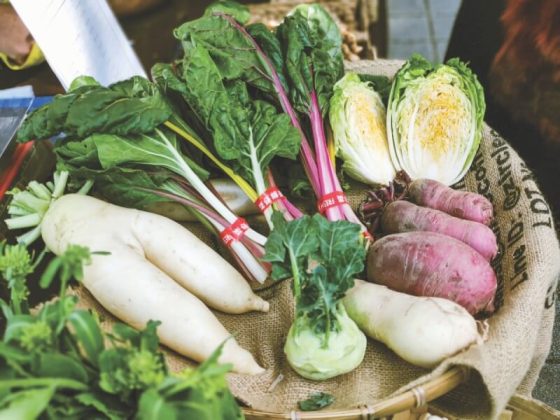A small sheet metal-clad one-story shop stands beneath the bustling Jianguo Elevated Road (建國高架道路), a unique building not often seen among the countless high-rises of Taipei. We ring the doorbell and are greeted by the host, Jun-Hsien Huang (黃俊憲), better known as Little T (小T), wearing a backwards baseball cap. He steps aside, and leads us into his recently opened bar, HiBoRu (嗨啵嚕).
The contrast when walking in the door cannot be more striking. Underneath the sheet metal roof are several exposed beams hung with small signs written with various Japanese slogans. A tall, thin, red Japanese KIRIN refrigerator stands in front of a polished glass window. Behind the window is a professional kitchen, with chefs frantically preparing dishes. On the other side of the store, a nostalgic macaron green-themed tile wall in full retro 1980s style stands out against the white and yellow tiles. Looking behind the bar, various wine bottles and glasses are sorted into different categories, quietly sleeping in two wooden cabinets.
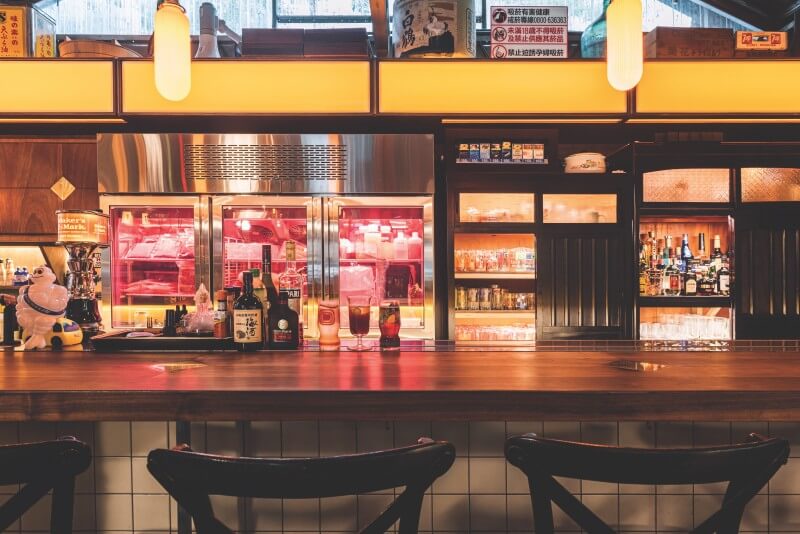
“Have a seat.” Little T brings out a cold soda and directs us to a corner of the store. We sit down and get ready to have a “highballing” conversation.
The True Meaning of Highball: Simple, Classic, and Profound
Growing up in southern Taiwan in the 1980s and 1990s, bartender Little T began his career as a teenager, joining the catering industry right after graduating from high school. At the age of 28, Little T decided to move to Taipei, seeking greater challenges in the bartending industry. After almost 15 years, Little T was inspired to start his own business, HiBoRu. (Read also: Bars in Taipei: Secret Promised Land of the City)
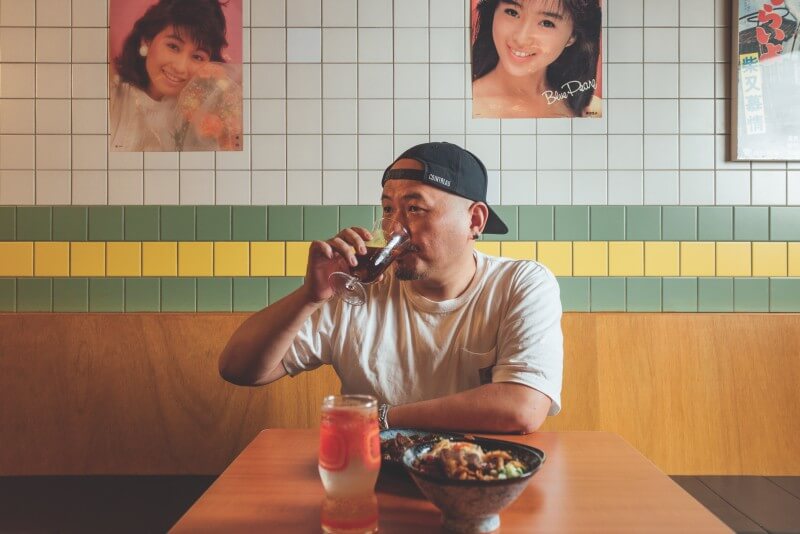
The name of his bar is derived from the Japanese pronunciation of the classic highball, and for Little T, who is the Diageo World Class champion in Taiwan, this is among the timeless classics of all alcoholic concoctions. “Any spirits with soda can be classified as a highball. It’s the easiest cocktail to make yet the most profound one,” he explains. The use of simple base spirits with soda water is in fact the core of HiBoRu’s existence. “I wanted to open a simple restaurant, serving simple drinks and simple side dishes, just like a highball,” he notes effusively.
The seemingly simple idea took more than a year of preparation and planning, and when it comes to the special retro atmosphere of the store, Little T’s idea could be said to be rather “highball”-ish. “I thought that if I were to open a store in Taipei, I would like to recreate the memories of my formative years. To me, the 1980s is classic, and everything you see in the store is what was trendy then!”
Evolution of Bar Culture
Having worked in both the north and south of Taiwan, Little T is a witness to the development of bartending in the country. In the early days of Taiwan’s modern society, there was a negative stereotype of bar culture. “When I told my family that I wanted to learn bartending, everyone thought I must have had a bad influence,” Little T recalls. This stereotype has its origins. According to Little T, the first bars in Taiwan were closely related to the presence of the U.S. military. There were news stories of GIs drinking and causing trouble. “In the past, most people went to drink for entertainment rather than the taste, and the quality of the drinks was rather bad,” he notes.
Little T found that there weren’t too many bars for customers in southern Taiwan to choose from when he first joined the industry, hence customers were accustomed to only drinking at a few familiar establishments. Meanwhile when he arrived in Taipei, he found that the bar selection in the city was completely different. “In the past, there were a lot of business customers in Taipei who would go for a drink along a row of bars on Anhe Road (安和路). Everyone was always bar hopping from one to the next.” Such a difference, however, became more and more blurry according to Little T. After the 1990s, a lot of international bar chains moved into Taiwan, giving people more and more options when it comes to drinking. “TGI Fridays was the most important player that influenced the bartending scene in Taipei in particular…Yes, TGI Fridays!” Little T quips, seeing our doubtful expressions. (Read more: 4 Taipei Bars Named in Asia’s Top 50)
When one thinks of TGI Fridays today, most people would not relate it to cocktails but rather dining. However, Little T assures us repeatedly that in the past, the availability of alcohol at TGI Fridays produced the first bartenders in Taipei who really understood bartending in the nascent bartending scene. “The TGI Fridays system laid down many of the rules of the bartending industry in Taipei, such as bartending ratios, bartending terminology, and even bar cleaning and glass washing, using a strict SOP training and mentorship system. My mentor also came from the TGI Fridays system, and I am still cultivating newcomers in this method!”
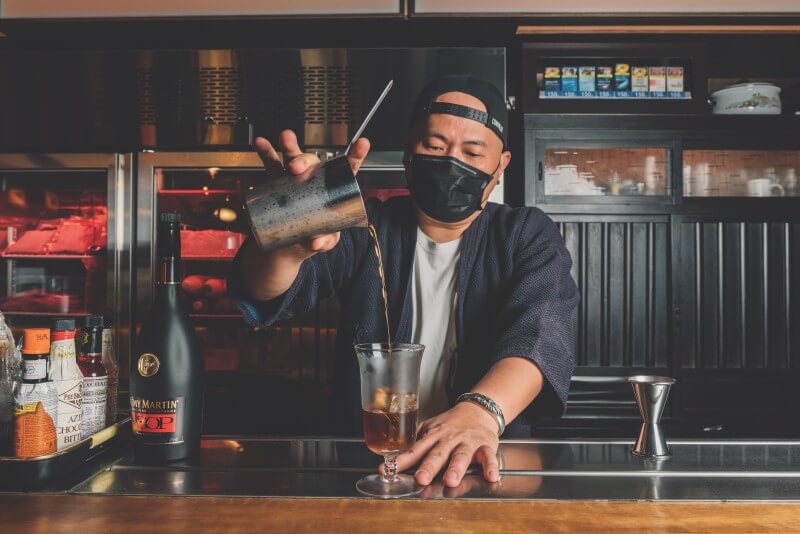
Taiwanese Bartending on the World Stage
With continued internationalization, Little T won the championship of Diageo World Class in 2011 and became well known in the Taiwanese bartending scene. He believes that the arrival of this type of international competition in Taiwan has contributed to the professionalization of the bartending industry in Taipei. “What Diageo has been promoting is to bring back the understanding of what ‘classic bartending’ is. For example, where does Long Island Iced Tea come from? What are the key ingredients? What should it taste like? This has led bartenders to seriously study the origins and methods of preparing various drinks,” he says matter-of-factly.
For those who attempt to represent Taiwan on the international stage, besides learning the classic flavors, there is another aspect to consider. “When I say I’m from Taiwan at international bartending competitions, not many people really recognize me. Therefore, bringing Taiwanese flavors into bartending is the best way to make the world recognize us, which is also a kind of a holy mission for Taiwanese bartenders,” Little T suggests.
The bartending scene in Taipei today is awash with the practice of infusing drinks with special ingredients. This sets the perfect stage for Little T’s imagination to truly flourish. For example, one of HiBoRu’s signature drinks, the “Black Cat Kayako (黑貓伽椰子),” is based on the floral scent of the classic brandy Remy Martin, mixed with the slightly bitter coffee roasted and brewed by the famous store Black Gui Cafe (鬼咖啡) in Tainan. With a touch of absinthe and kumquat juice to add a layer of bitterness, the alcohol and caffeine calm your nerves. Another drink, “Red Suspense (赤色懸疑),” incorporates the indispensable fruit elements of Taiwan, using hand-boiled roselle fruit to make syrup, with the aroma of beet juice and the freshness of mulberry vinegar. Based with Campari liqueur from Italy, which is famous for its bright red liquid and bitterness, the pronounced taste is especially suitable for a laid-back evening. (You might also like: A Tale of Cocktails: Five of Taipei’s Freshest Bars)
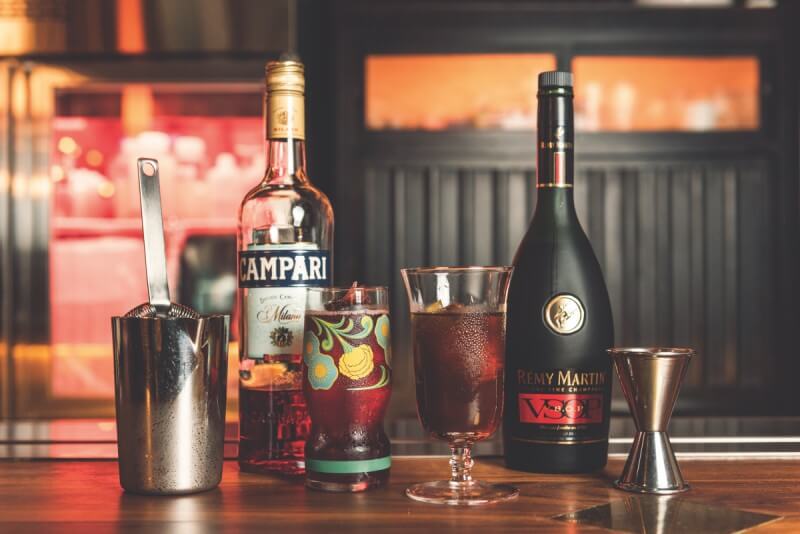
Traditional Side Dishes to Elevate the Flavor of Cocktails
Some bars in modern Taipei use special décor to win the attention of customers, while others use flashy cocktails. What makes HiBoRu stand out, in addition to cocktails, are the side dishes that are usually not given much attention in general bars.
Little T’s parents hail from Tainan, known as the culinary capital of Taiwan, and raised him on traditional southern-style soy-stewed pork rice and other braised dishes. This naturally inspired Little T to develop side dishes that go well with his drinks. “I don’t want people to think of my place as just a bar, but if they pass by and want to sit down, they can also have a relaxing meal,” he notes.
Unlike conventional soy-stewed pork rice, which is traditionally cooked with rice wine, HiBoRu uses bourbon. Little T first jokes that whiskey was more plentiful than rice wine in his store, and then explains, “The biggest function of rice wine is to remove fishy smells. But with whiskey, in addition to removing that smell, it can also bring out the full aromas of the fatty pork.” (Read more: In Appreciation of Taiwan’s ‘National Dish’—Braised Pork Rice)
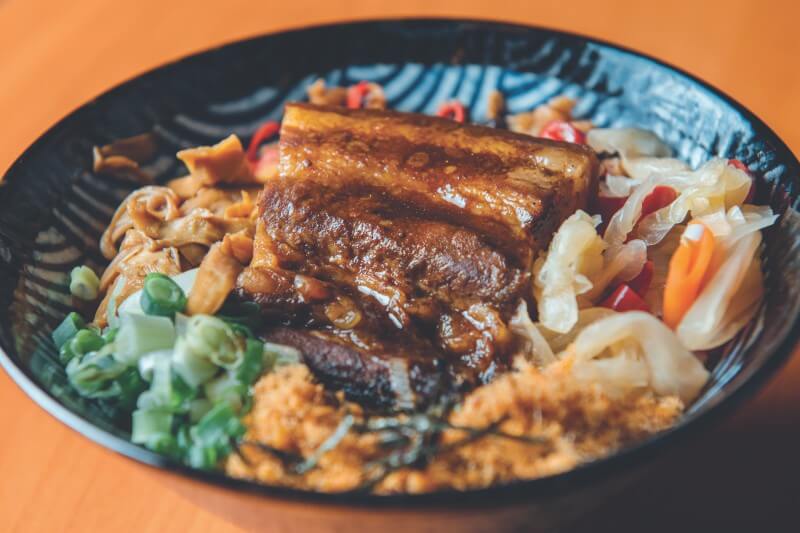
Another popular braised dish platter at HiBoRu includes quail eggs, beef tripe, beef brisket, chicken gizzards, peanuts, etc., each of which can exude the fragrance of the unique marinade. According to Little T, because the braised ingredients have different characteristics, the required stewing time also varies, so each ingredient is cooked separately with extra effort to ensure a consistent level of flavor.
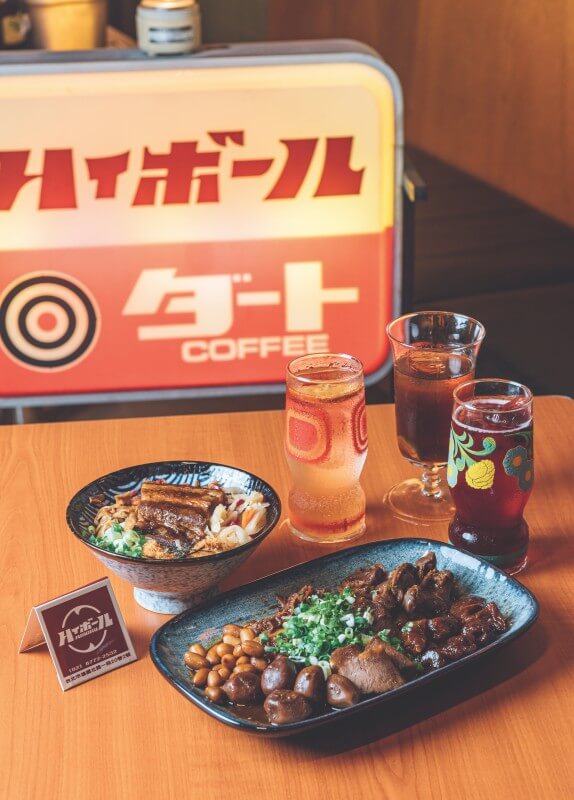
Nowadays, bars are springing up all over Taipei. From the food to the décor, and to the most important element — bartending — HiBoRu pairs complexity with simplicity and embraces innovation and the classics equally. Like Little T’s simple yet classic Highball drink, only soda water is needed to add a little excitement, which when paired with spirits to create a timeless classic, continues to move the heart
Making Taiwanese Flavored Cocktails with Little T
Want to enjoy a glass of distinct Taiwanese flavors at home? Try plum wine with asparagus juice, which is commonly found in convenience stores in Taipei. The two beverages come together in an unforgettable combination of sweet and sour, creating an unexpected burst of flavors that is perfect for a lazy early autumn day.
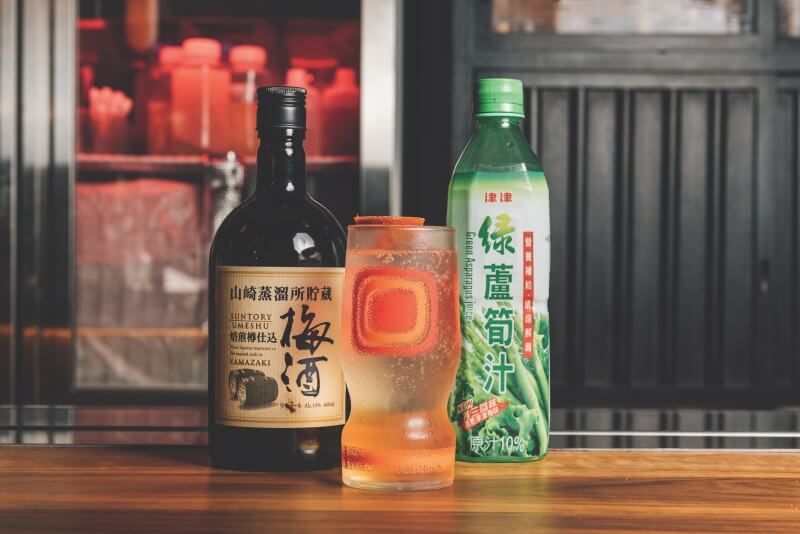
– INGREDIENTS:
➊ Plum wine – 40ml (any brand is fine, pick your favorite!) Asparagus juice – 40ml
➋ Soda water – 100ml
➌ Ice cubes – several
➍ Dried orange – optional
– OTHER KIT:
➊ Glass – 200ml~300ml
➋ Measuring cup – 1pc
➌ Mixing stick or spoon – 1 pc
– DIRECTIONS:
➊ (Optional) Chill the empty glass in the freezer for 2 to 3 hours before making the drink to get a better taste.
➋ Place a few ice cubes in the chilled glass, the amount can be adjusted according to your preference.
➌ Measure 40ml of plum wine and pour into the glass.
➍ Measure 40ml of asparagus juice and add to the glass.
➎ Measure 100ml of soda water, add in plum wine and asparagus juice.
➏ Stir the mixture carefully with a stirring stick or spoon.
➐ (Optional) Garnish the floating ice cubes with a few slices of dried orange for an extra touch of flavor, both visually and in taste!
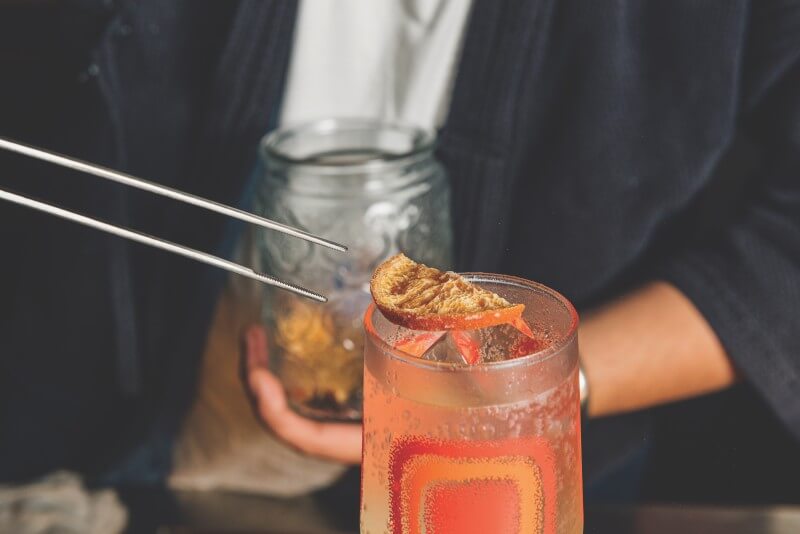
– Tips!
It doesn’t matter if you don’t have a measuring cup at home. You can easily create the best flavor by visually measuring plum wine, asparagus juice, and soda water in another container and grasp the ratio of 1:1:2.5.
| HIBORU |
| ADD 2, Ln. 20, Sec. 1, Jianguo N. Rd., Zhongshan Dist. HOURS 6:00pm – 2:00am (Closed on Sundays) |
Author Jamie R. Wood
Photographer Samil Kuo
This article is reproduced under the permission of TAIPEI. Original content can be found on the website of Taipei Travel Net (www.travel.taipei/en).
| COVID-19 ALERT |
| Opening hours may vary during the pandemic. Please double check before visiting, and follow the epidemic prevention regulations on site. |


